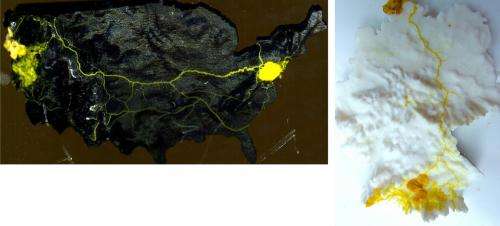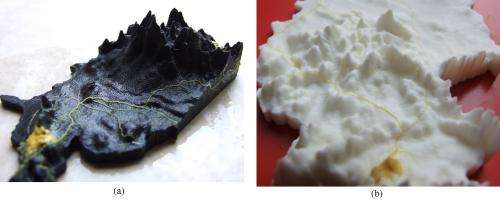3D terrains of the US and Germany show slime molds as they move their protoplasmic tubes toward food sources at opposite ends of the countries. Credit: Adamatzky. ©2013 IEEE
Slime molds may not have brains, but that isn't preventing some computer scientists from investigating them for their potential as novel, unconventional computers. A slime mold consists of a single cell containing millions of nuclei, and forms a network of protoplasmic tubes to move toward its food source along nearly the shortest paths. Since the challenge of finding the shortest path between two points is a much studied problem in computing, with applications in communication networks, robot path planning, and optimization, slime molds may hold some untapped potential for these areas.
In one of the latest studies in nature-inspired computing, Computer Science Professor Andrew Adamatzky at the University of the West of England in Bristol has experimentally demonstrated that the spongy, yellow slime mold Physarum polycephalum can navigate on 3D terrains to approximate real roads. Although previous studies have shown that slime molds do this on 2D terrains, this is the first time it has been shown on 3D terrains. The research is published in a recent issue of IEEE Transactions on Cybernetics.
"By my work with slime molds I show that we can design fully functional, and nearly general purpose, computers with almost any living substrate," Adamatzky told Phys.org. "No intelligence is required to compute but only basic responses to chemical, optical, tactile and maybe gravitational stimulation."
Adamatzky used 11-cm-long 3D Nylon terrains of the US and Germany, replicating the mountains and valleys using elevation data. He showed that the slime molds' transport routes closely approximate Route 20, which at 5415 km (3365 miles) is the longest road in the US, and Autobahn 7 in Germany, which at 963 km (598 miles) is the longest national road in Europe.
Experimental results of the slime molds’ transport routes when inoculated in Newport, Oregon, US, and Flensburg, Germany, with oat flakes placed in Boston, Massachusetts, US, and Fussen, Germany. Black lines represent route 20 in the US and autobahn 7 in Germany. (a) and (b) show results on flat agar models, while (c) and (d) show results on 3D Nylon terrains. Credit: Adamatzky. ©2013 IEEE
To demonstrate, he placed the slime molds at one end of each road (Newport, Oregon, US, and Flensburg, Germany) and oat flakes at the other end (Boston, Massachusetts, US, and Füssen, Germany). By sensing airborne chemicals released from the oat flakes, the slime molds took about 4-5 days to reach Boston and 2-3 days to reach Füssen from their respective starting points. Although the propagation distance is about the same on each terrain model, the steeper elevations in the western US may explain why the slime mold on the US terrain took longer.
Adamatzky performed several experiments on both 3D terrains, as well as experiments on flat terrains in the shape of each country. Although the slime molds' paths closely approximated the real roads, Adamatzky also observed that no two paths are exactly the same. He explains that this variability is not simply due to randomness, but instead occurs because the slime molds have different physiological states and metabolic rates.
As a result of these differences, some slime molds are more energetic and vigorous than others. These more active slime molds are better at climbing up elevations and so they take fewer deviations, resulting in a more direct and shorter route than their less active peers. These observations led Adamatzky to the conclusion that the slime molds do not compute the shortest path per se, but the optimal path for the amount of resources involved.
Overall, some of the slime molds built transport links that were slightly longer and some slightly shorter than the real roads. On the 3D German terrain, only one of the slime mold links was shorter than Autobahn 7, which could be due to the fact that road engineers have the advantage of digging tunnels through mountains and building bridges over ravines.
Examples of slime molds navigating around mountains in (a) the US and (b) Germany. Credit: Adamatzky. ©2013 IEEE
Although these results are interesting in their own right, Adamatzky predicts that slime molds and other living organisms have much more to offer to the field of computing in the future. For instance, perhaps these unconventional computers could help researchers discover novel principles of efficient information processing that can be used to develop future algorithms that are more efficient than those used today. They could also have implications for image processing, graph-theoretic computing, and the synthesis of new materials, among other areas.
Looking toward the future, Adamatzky is designing a hybrid device that combines a slime mold with conventional electronic computers. A year ago he received a $2.1 million GBP by the European Commission to build such a computer. Now with funding from the EU Unconventional Computation program, he is building a slime mold computer named PhyChip (http://www.phychip.eu/).
More information: Andrew I. Adamatzky. "Route 20, Autobahn 7, and Slime Mold: Approximating the Longest Roads in USA and Germany With Slime Mold on 3-D Terrains." IEEE Transactions on Cybernetics, Vol. 44, No. 1, January 2014. DOI: 10.1109/TCYB.2013.2248359
© 2014 Phys.org. All rights reserved.

























